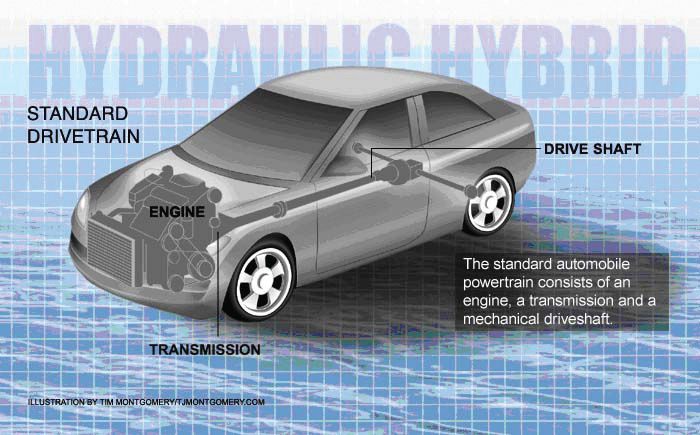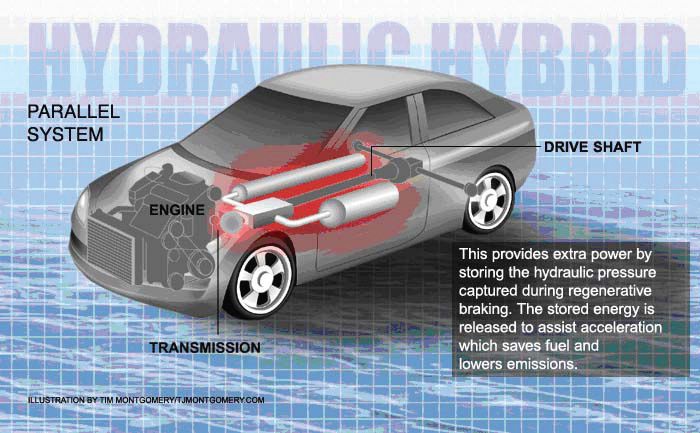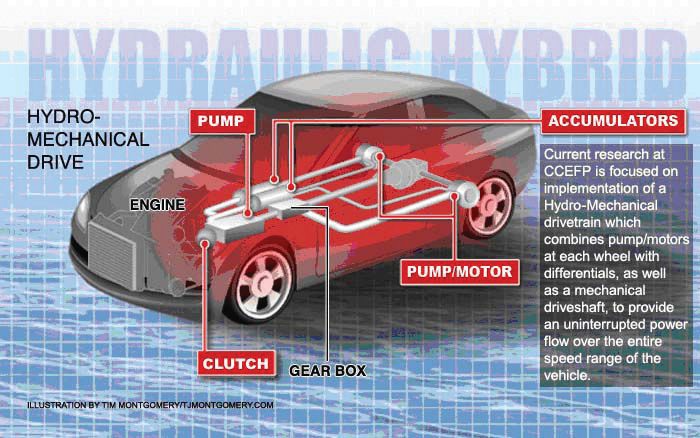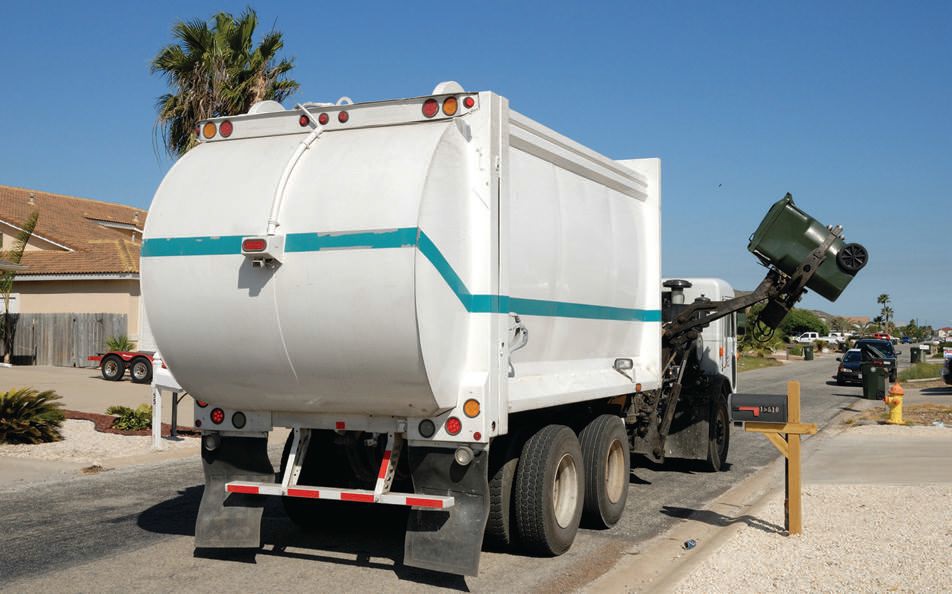Power to spare: Hydraulic Hybrids
Jean Van Rensselar, Contributing Editor | TLT Cover Story January 2012
Already in use in large commercial vehicles, researchers are close to deploying this technology in passenger vehicles.
KEY CONCEPTS
•
Super-fast charging and discharging accumulators make hydraulic hybrids possible.
•
Hydraulic hybrids are ideal for heavy commercial vehicles and already are in use for refuse and delivery trucks.
•
Hydraulic hybrids are more engine efficient, capture better braking energy and often have a much cleaner environmental footprint than their electric hybrid counterparts.
EPA DEVELOPED AND PATENTED HYDRAULIC HYBRID TECHNOLOGY IN THE 1990S with the first working hydraulic hybrid vehicle introduced in 2006. It was a United Parcel Service diesel delivery van that used technology developed by EPA’s National Vehicle and Fuel Emissions Laboratory and industry partners. This technology has since been incorporated into commercial vehicles such as UPS trucks, garbage trucks and city buses. EPA currently holds more than 30 patents related to hydraulic hybrids—with more pending.
Hydraulic hybrids are based on hydraulic components (accumulators) rather than electric components (batteries). While hydraulic hybrids have much in common with electric hybrids, the main difference is that with hydraulic versions energy storage takes place in a high-pressure hydraulic accumulator rather than a battery. Fluid power is stored in accumulators, just as power is stored in a battery, but unlike hybrids with electric motors, accumulators don’t require rare-earth metals and can have very high charge and discharge rates—less than 10 seconds.
A hydraulic accumulator is a pressure vessel that is used to store potential energy in the form of pressurized fluid. This stored energy is a readily available source of power that can respond quickly to changes in system conditions. Accumulators are routinely used to absorb shock loads in vehicle suspension systems and dampen high-pressure pulsations in hydraulic circuits. They also can serve as a failsafe in fluid power systems where an interruption of power creates a hazardous loss of machine control. When installed in a circuit that requires a variable flow rate, an accumulator can store excess pump capacity until it is needed. This can save energy by making the use of smaller pumps and power supplies possible.
When it comes to passenger cars, the regenerative braking capabilities of hydraulic hybrids can significantly outperform the electric hybrids now on the market—a feature made possible by the high power density of accumulators and other hydraulic components. EPA’s hydraulic hybrids typically capture 70% or more of the braking energy otherwise lost to heat, while electric hybrids capture 20% to 25% (
1).
As a result, there is growing interest in the use of accumulators for power storage, particularly in hydraulic hybrid vehicle and wind turbine applications. These fluid power applications create new market opportunities for lubricant manufacturers.
The EPA’s Hydraulic Hybrid Test Vehicles (2)
EPA, in cooperation with its partners, has successfully installed and tested hydraulic hybrid technology in a variety of vehicles. These prototypes have shown tangible results, including fuel economy improvement from 30% to more than 100% over similar conventional vehicles.
Full series HHV in a UPS delivery vehicle. On June 21, 2006, EPA and its partners: Eaton, UPS, Parker, International Truck and Engine Corp., the U.S. Army, FEV, Morgan-Olson and Southwest Research Institute, announced the world’s first series hydraulic hybrid urban delivery vehicle. The vehicle underwent real-world testing by UPS in 2006 and 2007 with the following results:
•
60%-70% improvement in fuel economy.
•
A projected 2-3 year payback when produced in high volume.
Series Hydraulic Hybrid Yard Hostler. A yard hostler is an off-road truck used to transfer cargo containers at marine ports, rail yards, warehouses and distribution centers. EPA and its partners created a highly efficient yard hostler using hydraulic hybrid technology with the following results:
•
Estimated improved fuel efficiency of 50%-60%.
•
Reduced maintenance and operation costs.
•
Reduction of emissions and greenhouse gases by over 30%.
Full series HHV in a Ford Expedition SUV. This hydraulic hybrid demonstrated fuel savings resulting from combining a full series hydraulic hybrid system with a diesel engine. The prototype was installed in a 2003 Ford Expedition SUV with the following results:
•
85% improvement in fuel economy over a diesel engine.
•
A less than two-year payback when produced in high volume.
•
Expected net lifetime savings from $4,000 to $6,000 from fuel costs and brake maintenance.
•
Excellent performance.
Parallel HHV in a Ford F-550. This Ford F-550 parallel hydraulic hybrid vehicle was built to demonstrate the benefits of parallel hydraulic hybrids and to examine the cost-effectiveness of parallel systems with the following results:
•
Demonstrated the ease of retrofitting trucks with hydraulic hybrid technology.
•
20%-30% improvement in fuel economy.
Full series HHV in a passenger car test chassis. In the 1990s the Partnership for New Generation of Vehicles was established to help U.S. automakers design a family-sized sedan that could achieve 80 mpg. A team of engineers working at EPA’s National Vehicle and Fuel Emissions Laboratory in Ann Arbor, Mich., succeeded in meeting this goal by using a revolutionary type of hydraulic hybrid (including a small 1.9-liter diesel engine) with the following results:
•
Attained 80-plus mpg on combined EPA city/highway driving cycles.
•
Accelerated 0-60 mph in eight seconds.
•
Showed no need for high-end lightweight materials to improve fuel economy.
•
In high volume, the hydraulic components would only add $700 to the base cost of the vehicle (EPA estimate).
HOW IT WORKS
There are three main types of hybrid drive trains: parallel, power split and series (all three types can regenerate braking energy).
1.
A parallel drive uses a pump/ motor to assist the engine, sending a high percentage of the wheel energy through the mechanical shaft. The downside is that it doesn’t balance torque and speed as well as a series drive.
2.
A series drive transmits engine power to the wheel using hydraulic motors and pumps. The engine operates with an efficient balance of torque and speed, but it doesn’t capitalize on the high efficiency of pure mechanical power transmission through a shaft.
3.
The relatively new split drive combines the positive aspects of the series and parallel drive train designs.
The main components in a full series hydraulic hybrid vehicle include:
•
A high-pressure accumulator tank. This stores energy by using hydraulic fluid to compress nitrogen gas inside the tank.
•
A rear-drive pump/motor. This acts as a motor by converting pressurized hydraulic fluid into rotating power for the wheels. This component also captures braking energy by pumping hydraulic fluid back into the high-pressure accumulator.
•
A low-pressure reservoir tank. This holds the spent fluid after it has been used by the rear drive pump/motor.
•
A front engine pump/motor. This creates additional high-pressure fluid needed to drive the vehicle, storing any excess in the high-pressure accumulator tank.
•
A hybrid controller. This monitors the driver’s acceleration and braking. It also sends operating commands to the various hybrid system components (
3).
 For comparison, a standard (non-hydraulic) drive train in a passenger car.
For comparison, a standard (non-hydraulic) drive train in a passenger car.
 Parallel drive system hydraulic hybrid technology in a passenger car.
Parallel drive system hydraulic hybrid technology in a passenger car.
 Hydro-mechanical drive system hydraulic hybrid technology in a passenger car.
Hydro-mechanical drive system hydraulic hybrid technology in a passenger car.
(Illustrations courtesy of the Center for Compact and Efficient Fluid Power)
Kim Stelson, director of the Center for Compact and Efficient Fluid Power (CCEFP) and professor in the department of mechanical engineering, University of Minnesota, says, “Advanced controls are essential to fully realizing the potential of a hydraulic hybrid vehicle. The advanced controls are needed to operate the engine efficiently and to decide when the engine should be turned off so that fuel consumption is minimized while also maintaining required performance.”
Typically the vehicle’s diesel or gas engine powers a hydraulic pump motor, which charges the accumulator (basically a high-pressure hydraulic fluid storage container). The accumulator drives one or more additional pump motors connected to the wheels. A second (lower pressure) accumulator usually completes the hydraulic circuit. Functioning as a motor, the hydraulic drive uses the pressurized fluid to rotate the wheels. Functioning as a pump, the hydraulic drive uses the momentum of the vehicle to repressurize the hydraulic fluid (in essence converting kinetic energy into reusable potential energy). During braking, the wheels’ pump motors reverse themselves and recharge the accumulator in the process. This captures energy otherwise lost to heat, which is also called “regenerative braking.”
Designs vary. There might be one pump motor to drive a pair of wheels through a differential or, in the case of an all-wheel drive version with independent torque, one pump motor per wheel. Although, hydraulic hybrids don’t need any electronics to function, many do have optional electronic controls.
THE ACCUMULATOR
STLE-member Paul Michael, research chemist at Milwaukee School of Engineering, says, “In terms of energy conservation, the use of accumulators in hydraulic hybrid vehicles holds great promise.”
Because they provide auxiliary power during peak periods, hydraulic accumulators are common in industrial and mobile hydraulic systems. Having the accumulators on board allows engineers to downsize some of the other system components such as motors, reservoirs and pumps by as much as 25%. Designers are looking for more ways to use accumulators due to the technology’s demonstrated ability to save energy, reduce operating costs, prolong useful life and handle demanding loads. One of those uses is as a highly efficient energy recovery and storage device.
A typical accumulator holds 8.5 gallons of fluid at a pressure between 1,150 and 2,175 psi. At a flow rate of 102 gallons per minute, it takes about five seconds for the fluid to discharge from the accumulator—the energy potential is impressive.
Since accumulators are sized to supplement pump flow, in order to size the accumulator correctly engineers only need to know minimum and maximum system pressure and the volume of fluid the accumulator needs to deliver. Some accumulator manufacturers make correct sizing even easier with software-enhanced calculators.
 ‘In terms of energy conservation, the use of accumulators in hydraulic hybrid vehicles holds great promise.’
OPEN VERSUS CLOSED ACCUMULATOR
‘In terms of energy conservation, the use of accumulators in hydraulic hybrid vehicles holds great promise.’
OPEN VERSUS CLOSED ACCUMULATOR
In a conventional or closed accumulator, energy can only enter or leave the accumulator through the hydraulics. The maximum energy is when the gas is at its minimum volume. In an open accumulator, energy can enter or leave the accumulator through either the hydraulics or the pneumatics. The maximum energy is when the gas is at its maximum volume.
In a closed accumulator, the pressure ratio is 3 to 1. In an open accumulator, the pressure ratio is 350 to 1. “These differences mean that the energy density of an open accumulator would be 20 times that of a closed accumulator,” Stelson explains. “But there are many technical challenges that need to be resolved in order to make this approach practical. We are busily working on them.”
STRAIN ENERGY ACCUMULATOR
While a conventional accumulator stores the energy in the compression of a gas, a strain-energy (elastomeric) accumulator stores energy in the elastic strain of an elastomer (such as rubber). “We estimate this approach could increase the energy storage density by a factor of five,” Stelson says.
He adds, “We have learned that the characteristics of the open accumulator make it more suitable for energy storage for wind power, and we are pursuing that application in the near term. With the maturing of open accumulator technology, it may well become practical for vehicles. The elastomeric accumulator is a better match for hydraulic hybrid vehicles at least in the near term.”
ADVANTAGES AND CHALLENGES
Hydraulic hybrids have three basic advantages over electric (battery) hybrids:
•
Much better engine efficiency.
•
They operate with the engine off more frequently.
•
They capture braking energy much better.
“Hydraulic hybrids have one very important advantage over electric hybrids— a much higher power density than electrics,” Stelson says. “This allows us to create a very powerful drive train in a small package. However, electric hybrids have the advantage of having higher energy density for storage. That is, batteries have a much higher energy density than accumulators, while also having a much lower power density. Our research is designed to address the energy density gap between accumulators and batteries.”
According to EPA, in addition to the fuel savings, the unique energy recovery technology used while braking reduces brake wear by 75%, increasing the net savings substantially. The additional cost for this technology manufactured in high volume could be less than 15% of the price of the base vehicle. The bottom line is that at current fuel prices, experts say this technology will pay for itself in 2-3 years. The net lifetime savings over a typical vehicle’s 20-year lifespan would be more than $50,000 (
4).
“Accumulators have an advantage over batteries in that they do not require rare-earth metals and they are capable of very high charge and discharge rates,” Michael says. “An accumulator can be fully charged in less than 10 seconds. Imagine charging your cell phone or laptop that fast.”
 Heavy vehicles rely on the high power of hybrid motors, storage components and controllers to haul and stop—hydraulic systems can do this, electric batteries cannot.
Heavy vehicles rely on the high power of hybrid motors, storage components and controllers to haul and stop—hydraulic systems can do this, electric batteries cannot.
Among the many advantages over hybrid electric systems:
•
Lighter weight. Vehicles equipped with hydraulic power systems are much lighter than those with purely electric systems. For example, electric hybrid vehicles using typical sodiumnickel- chloride batteries would be 100% heavier than hydraulic hybrid systems. Systems with nickel-metal-hydride batteries would be about 95% heavier than their hydraulic counterparts. There are many benefits to a lighter weight.
•
Much better power-to-weight ratio. The heavier the machinery, the more important this advantage. This is part of the reason why hydraulic hybrid systems were first introduced into heavy equipment. Heavy vehicles rely on the high power of hybrid motors, storage components and controllers to haul and stop—hydraulic systems can do this, electric batteries cannot.
•
Better energy management. Hydraulic hybrids can handle energy flow rates that far exceed braking requirements. Electric batteries, on the other hand, must be much bulkier in order to absorb energy at the rate needed for braking. Because of this, electric battery systems use a battery that can only be partially charged by braking (about 15%). This means that much of the spare storage capacity is wasted. Accumulator storage is matched exactly to the application.
•
Cost advantage and availability. Hybrid hydraulic systems are less expensive than electric hybrid systems. Pumps and air storage tanks are inexpensive when compared with batteries. In the case of retrofitting existing vehicles, installing hydraulic hybrid components requires only minor adaptations. Electric hybrid installation can require replacing the vehicle’s engine and/or transmission. Also, hydraulic hybrid systems have a longer useful life.
•
Hydraulic accumulators safely and easily discharge pressure. Some hydraulic systems automatically discharge when the vehicle is turned off. Hydraulic systems pose little or no risk of self-ignition, shock or fire. But because they rely on high voltage/current circuits, hybrid electric systems can present significant safety issues.
•
Environmental advantage. Most hydraulic hybrid components are made of long-lasting readily recycled materials. Electric batteries, by contrast, contain highly toxic materials such as concentrated acid and rare-earth metals that are difficult to dispose of safely.
•
Flexible in climate extremes. Hydraulic hybrid systems are less sensitive to extreme climate conditions such as moisture, heat and cold than their electric counterparts.
The high power density that yields high mileage and high performance should make hydraulic hybrid technology perfect for light-duty commercial vehicles and passenger vehicles. With their high regenerative braking capacity, hydraulic hybrid vehicles are already in limited use in applications that require lots of stop-and- go activity (such as urban delivery trucks).
However, the goal is to enter the passenger vehicle market, and this will require moving beyond three hurdles:
•
Size. Right now the accumulator would have to be larger than the size of most gas tanks. The trick is to develop a more compact accumulator without compromising power. Perry Li, professor of mechanical engineering at the University of Minnesota and co-lead (with Tom Chase) of the hydraulic hybrid passenger vehicle test bed, explains: “Current accumulator technologies are not very energy-dense, i.e., it takes a large volume to store a certain amount of energy. In fact, it is 100 times worse than the electric battery in this regard. More compact accumulators are needed so that they can fit in passenger cars.”
•
Unfamiliarity. The system isn’t any more complex than an electric hybrid; it’s just that the components are not mainstream when compared to electric hybrids. Electric hybrids also have the advantage of being a proven technology in real-world passenger vehicles, while hydraulic hybrids are not there yet.
•
Noise. Whereas electric hybrids can be ghostly quiet, hydraulic hybrids emit a loud (some say annoying) hissing sound. This is easily solvable by using the same methods auto engineers use to muffle engine and hydraulic steering system noise.
Because of the extremely efficient regenerative braking capacity, hydraulic hybrids are a natural fit for heavy commercial vehicles that deal with stop-and-go traffic (commercial delivery, refuse trucks, etc.). Another plus is that trucks (as opposed to passenger vehicles) have plenty of room to accommodate a large accumulator.
 Hydraulic hybrids are a natural fit for heavy commercial vehicles that deal with stop-and-go traffic (commercial delivery, refuse trucks, etc.)
THE BOSCH REXROTH HRB
Hydraulic hybrids are a natural fit for heavy commercial vehicles that deal with stop-and-go traffic (commercial delivery, refuse trucks, etc.)
THE BOSCH REXROTH HRB
One highly innovative hydraulic hybrid for commercial vehicles is Bosch Rexroth’s HRB (Hydrostatic Regenerative Braking) system. The first refuse truck equipped with HRB was introduced to the public by Rexroth in September 2008. Commercial production began in October 2010. Right now there are HRB equipped vehicles operating in more than 10 cities.
The system is designed for commercial vehicles using conventional mechanical drive trains and a combustion engine. It decreases the load on the brakes during deceleration and the load on the combustion engine during acceleration, leading to a considerable reduction in fuel consumption and brake wear.
The HRB system components, suitable for refuse trucks with a gross vehicle weight between 18 tons and 26 tons, are based on serial production components which Rexroth has been producing for years. This ensures good availability, reproducible quality and a system that should last as long as the vehicle itself.
The HRB consists of:
•
An A4VSO. Variable axial piston unit for pump/motor operation with a displacement of 210 ccm, a maximum power of 233 KW and a maximum torque of 1.113 Nm. Multiplying this by the HRB gearbox ratio, and the rear axle ratio would result in a maximum brake and acceleration torque of approximately 10.000 Nm on the wheels.
•
A gearbox. Three different ratios are available (1-5; 2-2; 3-2), synchronized for the common rear axle ratios of the truck chassis manufacturers to achieve the best system efficiency and the highest fuel savings.
•
An accumulator. A high-pressure bladder accumulator with an integrated nitrogen bladder is compressed during braking and relaxed when the vehicle needs to accelerate again. The charging pressure is at 120 bar and the maximum pressure at 325 bar. In the current HRB system, two bladder accumulators are integrated. In both accumulators up to 0,15 KWh can be stored, according to the kinetic energy from braking of 30 km/h down to 0 km/h minus all losses (rolling friction, aerodynamic resistance, etc.).
•
A valve control block. The hydraulic control unit of the HRB system controls the flow of oil and ensures (through a pressure control valve) that excess pressure does not occur in the system at any given time.
•
An electronic controller. The electronic control device ensures that the HRB continuously runs safely, efficiently and comfortably. The goal is to reduce as much work for the driver as possible while at the same time maximizing savings.
•
Sensors. Over 10 different sensors (i.e., pressure, temperature and speed) ensure that the electronic control device is kept up-to-date on all system conditions.
A gearbox connects a hydraulic variable axial piston unit to the mechanical drive train to convert kinetic energy into hydraulic energy when braking. The axial variable piston unit operates as a pump and converts kinetic energy into hydraulic energy by loading a hydraulic bladder accumulator with hydraulic fluid, which brakes the vehicle. This process is controlled by a proprietary electronic controller along with a hydraulic valve manifold.
During acceleration the process is reversed (pressurized fluid discharges in a controlled manner from the accumulator and flows back through the variable axial piston unit). The fluid flow drives the piston unit, which acts as a motor by giving up its energy to the mechanical drive train and relieving the existing combustion engine. A pressure relief valve and electronic monitoring of all safety relevant system and vehicle variables contribute to the highest level of safety for both processes.
In a refuse truck, the HRB system reduces fuel consumption by up to 25% during collections (or urban driving). The 25% savings are based on a combination of different stop-and-go distances and a waiting period of 30 seconds after each stop. It also nearly doubles the lifespan of the driving brake (
5).
EXPANDING INTO NEW MARKETS
The future of hydraulic hybrid technology rests on the potential for reconciling improved environmental performance (decreased fuel consumption/ decreased pollution) and cost reduction—something researchers have made great strides toward in recent years.
In addition to keeping costs down, while improving environmental performance, the key to expanding hydraulic hybrid technology into the passenger vehicle market is to increase energy density (more power in a smaller design). In fluid power systems, this is accomplished by increasing the working pressure of hydraulic systems and the efficiency of hydraulic components without increasing size.
At the International Fluid Power Expo in March 2011, Charles L. Gray, Jr., EPA’s director of Advanced Technology Division, reported that the development of hydraulic components that reliably perform at 7,000 psi (500 bar) would advance the cause of hydraulic hybrids. With few exceptions, most hydraulic components currently perform at less than 6,000 psi (400 bar). As research now stands, this increase in working pressure cannot be achieved without a substantial (prohibitive) increase in hydraulic system weight.
PASSENGER VEHICLE RESEARCH
In spite of energy density challenges, there are significant efforts underway to implement hydraulic hybrid technology in passenger vehicles. A prototype BMW 5 Series hydraulic hybrid passenger car has been developed by Artemis Intelligent Power in Edinburgh, Scotland (
6).
In January 2011 the EPA joined forces with Chrysler to develop and adapt hydraulic hybrid technology for the light-duty auto market, starting with a Caravan (minivan). The goal is for the Caravan, using EPA’s own patented technology, to be a demo vehicle. Researchers expect that the hydraulic hybrid technology will increase overall fuel efficiency by 30%-35% on the highway and 60% in the city. This should reduce overall greenhouse gas emissions by 25% (
7).
Gray says that the key technical hurdles are the noise, vibration and harshness issues often associated with hydraulic hybrids.
The EPA is interested in hybrid vehicles because they are an economically attractive technology to reduce pollutant emissions, fuel consumption, oil imports and greenhouse gas emissions,” Gray says. “Our analysis and test results suggest the series hydraulic hybrids offer the highest efficiency at the lowest cost when compared to other options.”
CCEFP also is looking into the use of hydraulic hybrid technology in passenger cars. Its Test Bed 3 focuses on power-split design (which combines the positive aspects of the series and parallel drive train designs).
The Test Bed 3 team is currently developing two hydraulic hybrid passenger vehicles—each offers discrete research benefits. The Generation 1 vehicle was built in-house using the platform of an off-road, all-terrain vehicle (a Polaris ATV Ranger). The vehicle uses an input-coupled power-split architecture and has been retrofitted with a modular power train including a down-sized diesel engine, variable displacement hydraulic pumps and motors, an accumulator, sensors, actuators and control electronics. This enables experimentation with different pump, motor and energy storage technologies, including those developed in complementary CCEFP projects. However, the Generation 1 vehicle cannot be driven at speeds greater than about 25 mph due to concerns about vehicle stability.
“One lesson is that system architecture, components, control and expected drive cycles are very important and inter-related for overall efficiency and performance,” Li says. “For example, we found that the power-split and parallel hydraulic hybrid architectures, which make use of both mechanical gears and hydraulics for power transmission, are more efficient than series architecture that uses hydraulics exclusively, unless one has a super-efficient pump/motors.”
The Generation 2 vehicle currently being developed is built on the platform of a pickup truck. It has refined vehicle dynamics capable of highway speeds. Its power train uses a custom-built, continuously variable output-coupled power-split hydraulic transmission developed by Folsom Technologies that will be complemented with hydraulic accumulators to enable hybrid operation. The power train is attractive because it is built as a compact, highly integrated, self-contained package.
 ‘Hydraulic hybrid vehicles have the advantages of better fuel economy, better performance and lower cost compared to electric hybrid vehicles.’
‘Hydraulic hybrid vehicles have the advantages of better fuel economy, better performance and lower cost compared to electric hybrid vehicles.’
The Generation 2 vehicle will be able to withstand rigorous testing and presents an opportunity for the study of an alternate power-split architecture. Nevertheless, the integrated package prevents changing out the hydraulic pump/motors. Also, since it is not originally designed for hybrid operation, the transmission is not optimally sized and presents some control restrictions when operating in hybrid modes. Therefore, the Generation 1 vehicle is being continued despite the pending availability of the roadworthy Generation 2 vehicle.
Stelson explains: “The Gen-1 vehicle has been very instructive to us since it can be reconfigured as a parallel, series or power-split hydraulic hybrid. This flexibility has allowed us to compare the three approaches on a common platform. Based on what we have learned, we have upgraded the vehicle considerably in the last year or so. The modularity and flexibility of the vehicle allow us to use it to test new technology developed by CCEFP. The Gen-2 vehicle will allow us to test the power-split approach on a platform that is much more similar to production vehicles.”
The CCEFP’s ultimate goal will be a Generation 3 vehicle with a true passenger vehicle chassis. They plan to begin work on the vehicle sometime this year (
8).
“Hydraulic hybrid vehicles have the advantages of better fuel economy, better performance and lower cost compared to electric hybrid vehicles,” Stelson says. “These advantages are most pronounced in larger vehicles, which are now appearing in the marketplace. Passenger vehicles are more challenging to compete against since electric vehicles already have a head start. In the passenger vehicle market, the best candidates for hydraulic hybridization would be larger vehicles such as minivans and SUVs.”
He adds, “Besides the energy storage challenge, hydraulic hybrid passenger vehicles must be quiet and pleasing to drive. Research is currently ongoing to address the packaging, noise and driveability characteristics as hydraulic hybrid technology migrates to smaller vehicles.”
THE BOTTOM LINE
Hydraulic hybrid technology has already proven itself in commercial delivery trucks and vans where multiple opportunities for regenerative braking make it a perfect fit. But this is a limited market. If researchers can reduce the physical size of the accumulator and eliminate or significantly muffle the noise, this technology holds great promise for the passenger car market where the sheer potential for the technology’s ultra-rapid energy storage and discharge would be transformative.
“A main obstacle is the education of the general public. People need to know that electric vehicles are not the only—or necessarily the best—approach,” Li concludes.
REFERENCES
1.
From
here. This figure may be low. Stelson believes the Toyota Prius captures about 50% of the braking energy.
2.
From
here.
3.
From
here.
4.
From
here.
5.
Click here.
6.
Watch the video
here.
7.
Media release available
here.
8.
For more information, cick
here.
 Jean Van Rensselar heads her own communication/public relations firm, Smart PR Communications, in Naperville, Ill. You can reach her at jean@smartprcommunications.com
Jean Van Rensselar heads her own communication/public relations firm, Smart PR Communications, in Naperville, Ill. You can reach her at jean@smartprcommunications.com.